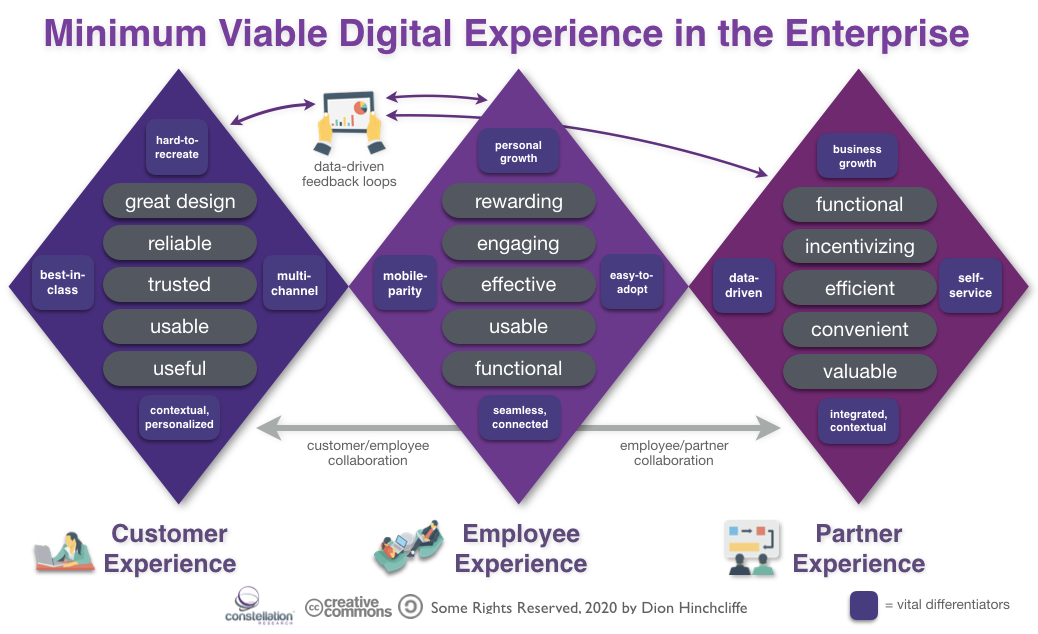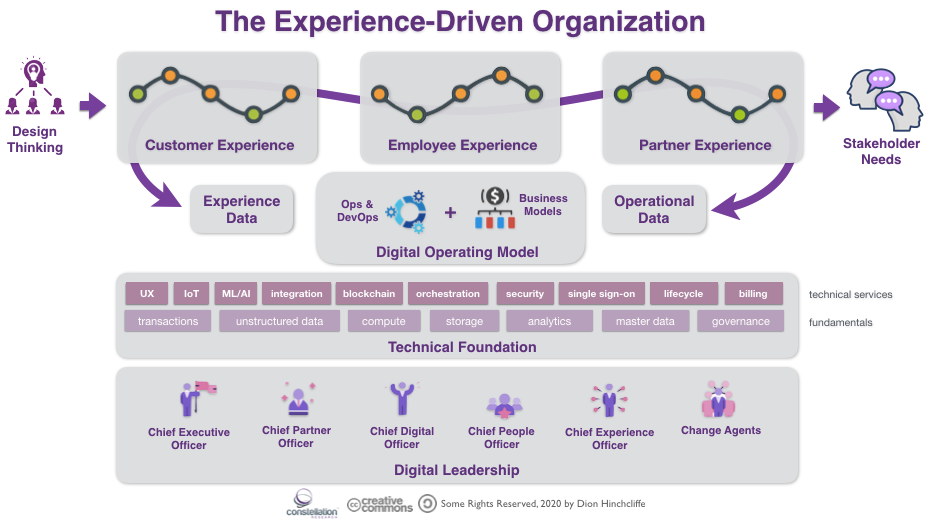It's been fairly apparent for several years now that our organizations are steadily shifting towards a vital new set of models for creating and exchanging value with stakeholders. The prime motivation for this is that the ever-more fragmented and siloed world of our organizations -- along with the technologies and digital tools that enable them -- has increasingly been unable to support how the modern world works today.
By this I mean broadly that organizations have steadily been moving away from the traditional model of siloed enterprise efficiency, where each type of task is carried out in specialized areas of the business for reasons of cost effectiveness, economy of scale, and required skills, to one where everything is seemingly connected to either one, two, or all three of the top-level value streams that now essentially constitute the vast majority of what most organizations do today to create value for their stakeholders and sustain themselves. (For those not familiar with the business jargon, a good definition of a value stream is the set of steps that a firm operating in a specific industry performs in order to deliver a product or service that is valuable.)
These value chains are so important to modern organizations -- essentially representing the trinity of core actiities that enterprises must focus on creating, innovating upon, removing all friction from, streamlining, and supercharging in effectiveness -- that to focus on anything else would mean to lose the game. Furthermore, the data tells us the story of the true state of affairs today: While 80% of organizations believe they provide a good customer experience, for example, as little as 8% of their customers agree.
The Three Core Stakeholder Experiences
This means that, for executive leaders, there is simply nothing more important today that focusing on ensuring the three main value streams of stakeholder experience not only right, but on a sustainable evolution for the long term. In rough order of importance, though all three are essential, these are the three core enterprise value streams: Customer experience, employee experience, and partner experience.
Why use the lens of experience to frame these value streams? Because the term experience describes the critical boundary across which value is exchanged with stakeholders. Creating and exchanging value is very the reason we exist as enterprises, and the experience is the most powerful construct we currently have to decribe the place where this happens.
Thus, customers experience a company through its products, services, and the workers that serve and support them. Employees experience their work through the physical, digital, and cultural aspects of their workplace. Partners experience their relationship with other companies through their associated physical, digital, and personal channels. Combined, these experiences form a complete operating model that we can reason and act upon.
All of this is a realization that's come slowly, however. Yet most of us have heard some form of the rallying cry of phrases like "Everyone is in marketing now." Or "all workers should be customer obsessed." And one of my favorites, "you can't have a great customer experience without a great employee experience." Although the future is indeed decentralized, what that really means is that most of the organization contributes in some way to these three experiences, yet far too much in isolation.
As businesses, we used to focus much more on individual processes, tools, and technologies in an organization were everything we did was already decomposed. Function was far more important than form or innovation in many cases, because efficiency and optimization was often the most highly prized in a world that didn't change much and in which there wasn't very much choice. These priorities -- while still key -- have been turned on their head by the Exponential Era. As I often say, leaders that attempt to cope with exponential change using yesterday's linear tools are hopelessly outmatched.
Data Fuels Both Experiences and New Change Models
The reality is that most organizations today are still running mostly open loop when it comes to real-time or even recent measurement of the effectiveness of their stakeholder experiences. Though they often have some data about customer experience, they usually have very poor operational measures of the key attributes of the other two value streams (shown in the first figure above.) This status quo has to change substantially if improvements are to take place.
As a result, I've long championed decentralized change at scale and growth to overcome the mismatch in approaches used -- though very much loosely coordinated centrally by leadership -- by using methods and tools that are matched to the scope and speed of the challenges and are also highly data-driven to ensure feedabck from reality rapidly goes back into the effort. I've been very fortunate to have been at the helm of several such efforts that have systematically employed exponential techniques like Networks of Excellence or distributed communities of change agents, both which work quite well to marshal far more change -- and are faster -- than traditional methods. I've closely watched other such efforts succeed in the industry as well. Overall, this is quite good news: We now have early but workable frameworks and tools that can effect transformation effectively and repeatably at scale.
However, as effective as such high scale change methods can be -- especially if they are carried out in conjunction with ready removal of any and all barriers between people, systems, and data in a coherent and integrated digital foundation -- it's my analysis that they are still held back by one last, very important obstacle. Namely our top level organizational structures that are organized around silos that typically cut right across, thereby literally disconnecting and disassociating, the three core experiences in our organizations.
Most of us are all too familiar with customers getting bounced around across marketing, sales, delivery, customer service, and other functions. Each one has its own silo that uses their own technologies, tools, and platforms, and typically rolls up to a C-level executive that has no accountability to any of the other functions. This creates large impediments in so many ways to offer a consistent and high quality experience for customers, for instance, despite the fact that great customer experience is the single most important differentiator for a business that there is. The reasons for similiar such issues in employee and partner experiences are different, but the results are the same: Complexity, dysfunction, inability to change, inconsistency, poor usability, stakeholder rejection, and the list goes on.
For organizations to survive and be competitive today, they must embark on an all-out effort to rapidly transform and organize around these three core stakeholder experiences. Otherwise, digital transformation and other large scale initiatives will continue to turn in the same very limited results until this restructuring is realized. This is in large part due to an effect known as Conway's Law, that says that no matter what you do, the design of your technology product or service will merely reflect the organizational structure of the entity that creates and operates it. For those not in the technology business, it's hard to understate how true this really is: Our new digital world, because of its connectedness, is generally a mirror reflection of how we go about creating it.
Becoming an Experience-Driven Organization
Thus, I've taken my last few years of research and put it into a first-gen operating manual of sorts on how to execute such an organizational shift. It's in a marquee new Constellation Research report titled "Experience-Driven Organizations." While you can consult the report for details, here is a summary of the key steps of the process below:
- Assess your organization honestly to determine the true maturity of current digital capabilities, end-to-end.
- Dispassionately compare these results against benchmarks and your industry peers.
- Turn key strengths and weaknesses into goals for digital capabilities, emphasizing streamlining and resilience.
- From these goals, develop new initiatives and org changes in a transformation roadmap using breakthrough new change methods at scale.
The reality is that organizations must systemically achieve a minimum viable set of modern stakeholder experiences in as short order as possible, and do so sustainably. It will require several bold changes in organization structure, a rapid shift to a modern technology foundation, and the relentless, even ruthless, removal of barriers to the key aspects of stakeholder experience. These key aspects are, again in rough order: Useful functionality, high usability, effectiveness of outcome, relability, trust, high engagement, and shared value creation. There are also stretch objectives within these experiences as well (see top figure above.)
As we learn more about how to structure and operate our organizations in this digital era, we will continue to learn new methods and approaches that will help us get there. It is currently urgent that we modernize our organiations for present conditions, where experiences are the core value streams that run our businesses. I believe the mindset and approach is a natural one that most organizations will eventually make on their own. We should consequently move the process along if that is the best end state. Finally, I am also finding it vital that we share best practices across the industry when we can, given how fast change is taking place. Please send me a note to share your own experiences on digital and business transformation and in this regard I'll summarize them with credit in any updates.
Additional Reading
Digitally transforming organizations into their three main experiences | ZDNet
Creating an Employee Experience as Great As Your Customer Experience
To Strategically Scale Digital, Enterprises Must Have a Multicloud Experience Integration Stack




